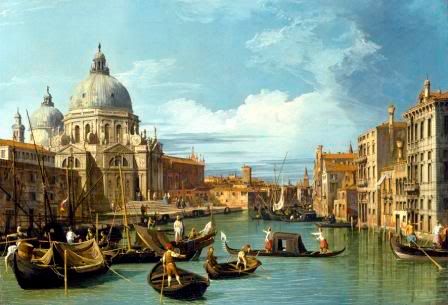
Canaletto's The Entrance to the Grand Canal, looking West, with Santa Maria della Salute, about 1729. © The Museum of Fine Arts, Houston. The Robert Lee Blaffer Memorial Collection, gift of Sarah Campbell Blaffer (56.2).
Monday evening as I strolled up to the National Gallery on my way to view the recently opened exhibition, Venice: Canaletto and His Rivals, I was struck by a rather amusing coincidence.
Work is being done to the front façade of the National Gallery and a wrap around the scaffolding sees a Credit Suisse-sponsored scene that imagines Trafalgar Square as a Venetian lagoon. "Canaletto Comes to London" it proudly proclaims, but the funny thing is that only a few weeks ago the art world was up in arms about similarly sponsored billboards in La Serinissima herself.
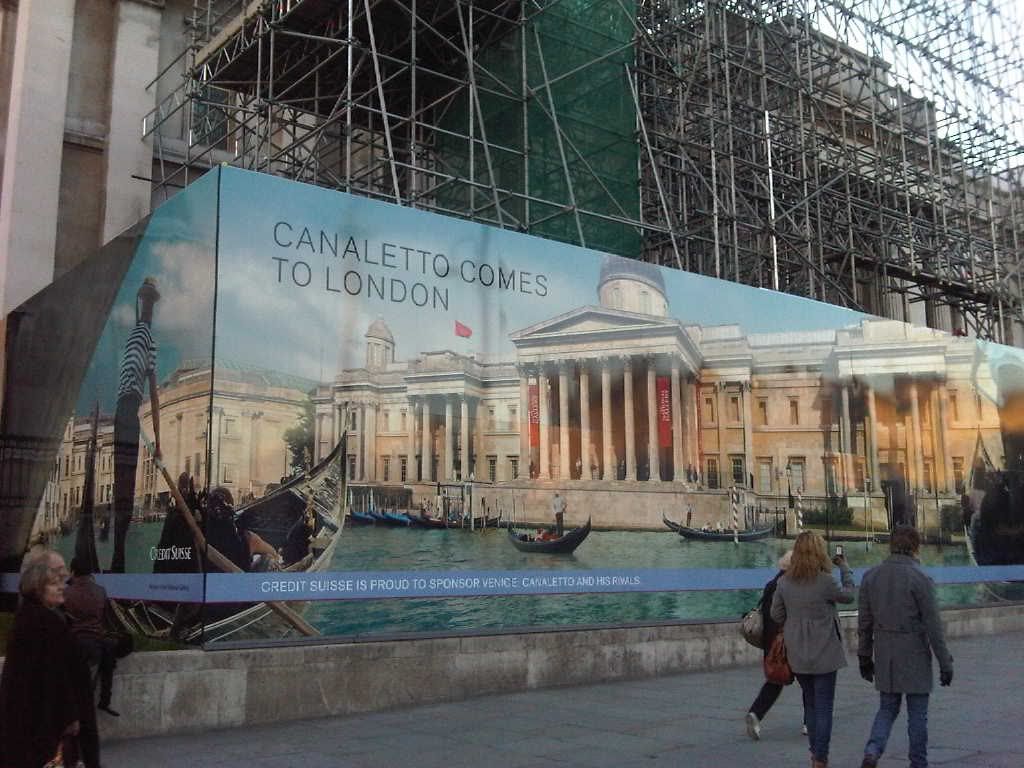
Venice's famous Ponte dei Sospiri (a name coined by Byron who romantically suggested that prisoners being led from the interrogation rooms on one side of the bridge to the prison cells in the Doge's Palace on the other side, would sigh at their last sight of the beautiful city while making the crossing) has of late been covered in huge ads for Coke, Chanel, and Bulgari. In a city like Venice, always fighting a battle between the built environment and, well, the environment, such ads have been common sources of raising restoration funds. But the current slew of advertisements, such as those surrounding the Bridge of Sighs, are different: they aren't about the city, but the brand footing the bill. At least with the old ads, one might come to some idea of what the original building looked like. Not only does the Bulgari ad completely obscure the Bridge, but it succeeds in enfolding the architecture of the city into a kind of gruesome ad campaign.
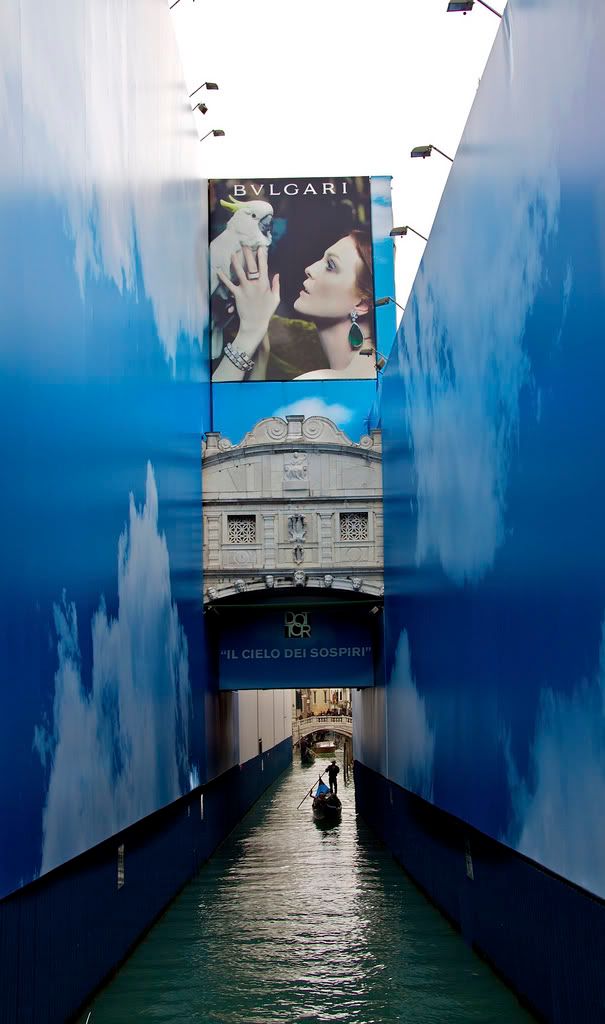

Venice's famous Ponte dei Sospiri (a name coined by Byron who romantically suggested that prisoners being led from the interrogation rooms on one side of the bridge to the prison cells in the Doge's Palace on the other side, would sigh at their last sight of the beautiful city while making the crossing) has of late been covered in huge ads for Coke, Chanel, and Bulgari. In a city like Venice, always fighting a battle between the built environment and, well, the environment, such ads have been common sources of raising restoration funds. But the current slew of advertisements, such as those surrounding the Bridge of Sighs, are different: they aren't about the city, but the brand footing the bill. At least with the old ads, one might come to some idea of what the original building looked like. Not only does the Bulgari ad completely obscure the Bridge, but it succeeds in enfolding the architecture of the city into a kind of gruesome ad campaign.

Image by Davers
As for the Canaletto show, it's surprisingly good, and I say surprisingly as someone who adores both Venice and Canaletto. I tend to find the exhibitions at London's major museums - especially the Tate “disaster-zone” Modern - utterly pointless and so attend with suitably lowered expectations. Venice is one of the most visited cities in the world, so its regular appearance as the subject of blockbuster exhibitions is no surprise: it brings in the big bucks. But despite its overwhelming popularity and resulting theme-park trappings, Venice has a subtlety only to be found once one diverts from the Grand Canal. Amusingly, I know a lot of people who don’t like Venice but I maintain that they either haven’t been with me or they haven’t been in the off season. Possibly both. Venice is incredibly beautiful, picturesque to the point of being grotesque, but it won’t give you anything for free. You have to go exploring, get lost, go for a swim, get off the Rialto and into Cannaregio.
It amuses me to think that in many ways, twenty-first century Venetian tourists are Canaletto’s heirs: making view pictures with their Minoltas and Canons instead of hog-hair brushes. The purpose is one in the same: wealthy tourists want a memento to remind them of their visit to this most beautiful city. In the eighteenth century, one might have bought Canaletto’s Entrance to the Grand Canal: Looking East (1744), whereas now one can snap a quick pic of the same scene on the Number 1 vaporetto chugging down the Canal. Just because the former is part of the Queen’s collection of art doesn’t mean that the self-styled snap is any less precious...
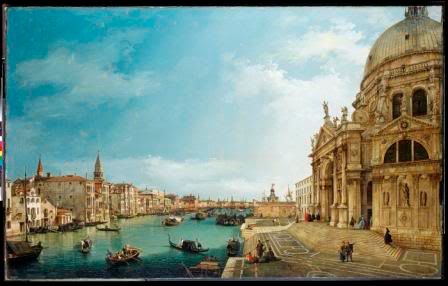
Canaletto. The Entrance to the Grand Canal, looking East, with Santa Maria della Salute, 1744. © 2010, Her Majesty Queen Elizabeth II
So, Canaletto’s paintings are beautiful – Venice at her loveliest, most golden, most unearthly – and the Grand Tourists head home with proof of the pudding, but what’s actually rather refreshing, even challenging, about the curation of this show is that it doesn’t rest on such an unexamined approach. In fact, the exhibition title gives it away – the star of this show isn’t Canaletto, but Venice – and the comparison of Canaletto with his nephew and protégée, Bellotto, as well as later view painter, Guardi, provides an illuminating juxtaposition to the differing approaches of the veduti painters. It’s tempting to use a Goldilocks analogy when considering the three: Bellotto too cold; Guardi too hot; Canaletto just right, but that hardly does justice to the subtleties of their styles. Canaletto’s later works are the easiest to take in, the most obviously beautiful, but such unchallenging beauty quickly wears thin. The Goldilocks analogy is particularly apt in the Bellotto room: one fascinating pairing has another of Canaletto’s scenes depicting the entrance to the Grand Canal sandwiched by two different attempts by Bellotto to paint the same scene. Of course, it’s impossible to tell whether Bellotto was making a concerted effort to distance himself from his uncle’s technique – quite likely – but neither painting has the harmony or the gorgeous diffused light of Canaletto. One attempt is too harsh, the other is too soft and Canaletto’s sits in between and sings.
But despite the beauty of Canaletto’s works, Guardi steals the show – while his images display all the hallmarks of view painting, his work feels less constrained by the demands of the genre or the whims of tourists: the lighting is stronger, less diffused and tonally there are more greys and browns, instead of the jewel tones omnipresent in Canaletto. A few of Guardi’s pieces look as if finished with India ink: thick, swift, black liquid brush strokes define window frames and architraves, where Canaletto is softer and more forgiving.
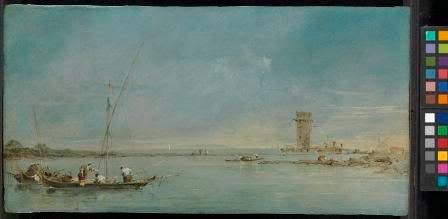
Guardi. The Lagoon with the Torre di Malghera, around 1770–80. © The National Gallery, London
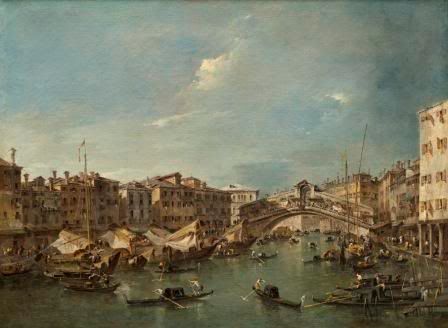
Guardi. The Grand Canal with the Rialto Bridge from the South, about 1780. © Image courtesy of the Board of Trustees, National Gallery of Art, Washington, DC. Widener Collection.
There’s something compelling and refreshing about the wild looseness of Guardi’s paintings after Canaletto’s over-idealised, disneyesque portraits of La Serinissima at her most clichéd. Though the city may be affectionately referred to as eternally serene on account of those familiar, sweeping vistas, Venice's history is one of turbulence and violence, and for all its fairy-tale beauty Canaletto’s work serves as a reminder that at the end of the day, in the world of art at least, the interests of money reign supreme.
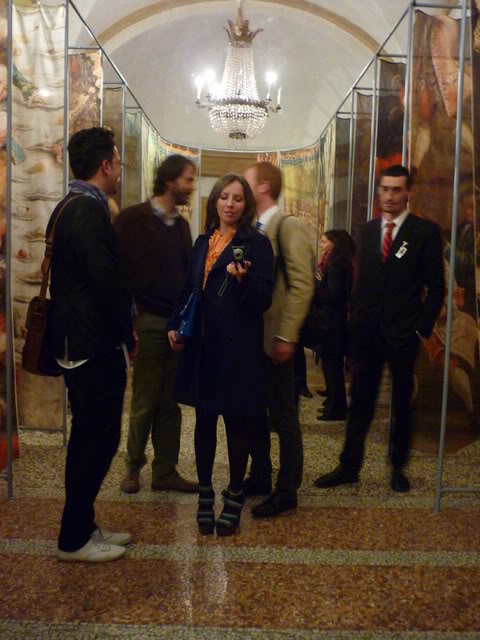



No comments:
Post a Comment